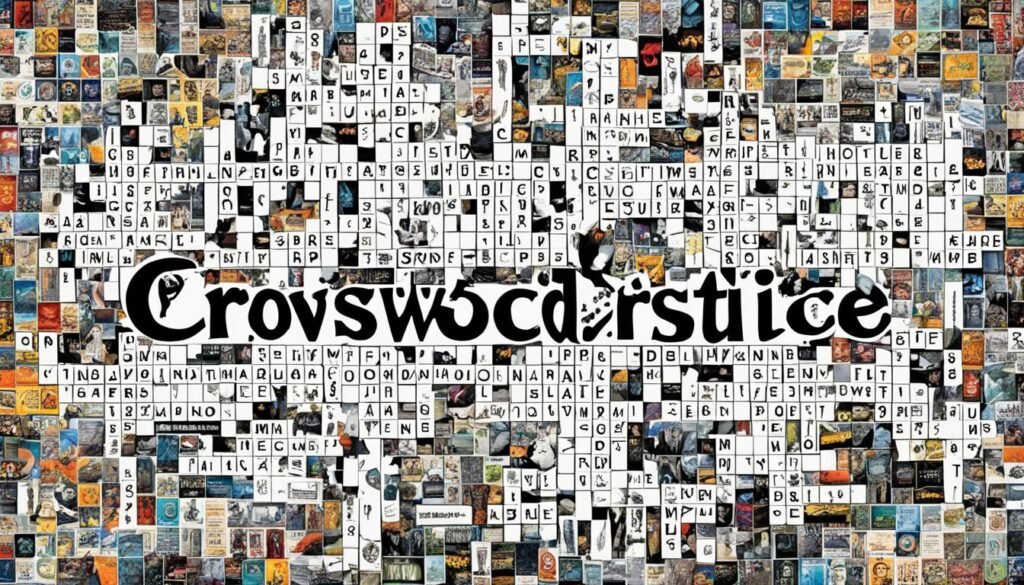The New York Times crossword puzzles offer a thrilling challenge for word lovers. One intriguing clue is “What a little birdie told me.” This phrase often stumps solvers with its clever wordplay and cultural references.
To crack this clue, you’ll need sharp language skills and pop culture knowledge. It’s a fun brain teaser that pushes you to think outside the box.
Key Takeaways
- The “What a little birdie told me” clue in NYT crosswords often involves clever wordplay and cultural references.
- Solving this clue requires a keen understanding of language, logic, and pop culture knowledge.
- Crossword puzzles provide a fun and engaging way to exercise the brain and improve cognitive skills.
- Exploring the techniques used by puzzle creators can give insight into the art of crafting clever crossword clues.
- Crossword enthusiasts can find satisfaction in the thrill of unraveling cryptic clues and discovering hidden meanings.
The Power of Wordplay in Crossword Puzzles
Crossword puzzles are more than vocabulary tests. They’re a captivating exercise in wordplay and linguistic ingenuity. Puzzle creators weave intricate clues that delight enthusiasts.
How Cryptic Clues Challenge and Delight Puzzle Enthusiasts
The thrill of solving cryptic clues is at the heart of crosswords. These puzzles hide multiple layers of meaning. They challenge solvers to think creatively and use their language skills.
Crossword puzzles are a playground for wordplay. They use puns, anagrams, and clever misdirections. These elements captivate brain teasers and puzzle enthusiasts alike.
Solving a tricky cryptic clue feels like unraveling a mystery. Puzzle makers blend seemingly unrelated elements. Solvers must find hidden connections, exercising their minds and feeling accomplished.
| Cryptic Clue | Explanation | Solution |
|---|---|---|
| Confused by a hint, I’m in the dark (5) | An anagram of “a hint” (ANAGRAM) indicates the clue is a scrambled word, and the length (5) suggests the solution is a 5-letter word. The phrase “I’m in the dark” implies the solution is a synonym for “confused”. | DAZED |
| Wise fellow from the east, perhaps (4) | The clue suggests the solution is a 4-letter word that refers to a “wise fellow from the east”, which is a common crossword puzzle trope for the word “sage”. | SAGE |
This table shows how cryptic clues use wordplay techniques. Anagrams, homophones, and double meanings challenge solvers. Recognizing these cues makes solving cryptic clues rewarding.
“Crossword puzzles are not just a test of vocabulary, but a celebration of language and a battle of wits between the puzzle creator and the solver.”
Wordplay in crossword puzzles captivates and stimulates minds. It turns a simple word grid into an exciting challenge. Puzzle creators use language creatively, making crosswords an art form.
Dissecting the “What a Little Birdie Told Me” Clue
Crossword puzzles often use clever wordplay and cryptic clues. The “What a little birdie told me” clue is a great example. It offers multiple meanings that puzzle enthusiasts love.
This clue hints at receiving insider information or a secret tip. The “little birdie” metaphor adds a whimsical touch. Solvers must think creatively to connect unrelated concepts and find the answer.

Puzzle makers use idioms, slang, and cultural references for what a little birdie told me nyt crossword clues. These crossword clues test players’ knowledge and language skills. They combine wordplay with logic to reveal hidden meanings.
Analyzing this clue helps us understand how crossword puzzles are crafted. It shows how wordplay enhances the solving experience. Creative clues like this make crosswords more engaging and fun.
The Art of Crafting Clever Crossword Clues
Crossword puzzles captivate word lovers with intricate webs of crossword clues and wordplay. These ingenious crossword puzzles challenge and delight solvers worldwide. Let’s explore the techniques puzzle creators use to craft engaging clues.
Mastering the Art of Misdirection
Clever crossword clues often misdirect solvers using puns and double meanings. This element of surprise keeps enthusiasts eager to unravel puzzles. Creators use unexpected interpretations to lead solvers down intriguing paths.
Tapping into Pop Culture References
Incorporating pop culture references adds an extra layer of challenge to crossword puzzles. Creators draw from movies, TV shows, music, and literature. These clues test solvers’ knowledge and resonate with a wide audience.
| Technique | Description | Example |
|---|---|---|
| Puns | Leveraging the multiple meanings of words to create clever double entendres | “Hog’s home” (answer: PEN) |
| Misdirection | Guiding the solver down an unexpected path to reach the solution | “What a little birdie told me” (answer: TWEET) |
| Cultural References | Incorporating familiar pop culture elements to challenge and engage solvers | “Classic TV detective” (answer: COLUMBO) |
Crafting clever crossword clues showcases creators’ creativity and linguistic skills. They use misdirection and cultural references to challenge solvers. This keeps crossword puzzle fans engaged and eager to expand their knowledge.
Pop Culture References in Crossword Clues
The New York Times crosswords blend wordplay with pop culture references. This mix challenges and delights solvers. These cultural nods add depth and humor to the puzzles.
Crossword clues span from movie quotes to internet memes. They test solvers’ knowledge of popular culture. These references create connections among puzzle enthusiasts.
A clue like “Bieber or Timberlake, e.g.” goes beyond dictionary definitions. It taps into solvers’ knowledge of modern music. TV or book references can spark nostalgia among fans.
Pop culture references engage both intellect and emotions. Puzzle creators balance accessibility and obscurity. This gives solvers a sense of achievement.
These cultural nods remain key to the crossword experience. They invite solvers to explore language, wit, and shared experiences.

Witty Puns and Wordplay in Crosswords
Crossword puzzles are more than just finding words. They’re a playground for word lovers. Witty puns and clever wordplay make these brain teasers fun and challenging.
Unraveling the Layers of Meaning and Misdirection
Puzzle creators use wordplay to make clues tricky and fun. They hide meanings and use misdirection. This turns crosswords into an exciting mental adventure.
Double entendres and homophones are common in crosswords. These word tricks make solving more engaging. They challenge solvers to think creatively.
The New York Times crossword often uses clever clues. “What a Little Birdie Told Me” is a great example. It’s not about birds, but insider information.
“Crosswords are a delightful blend of brain teasers and linguistic artistry, where witty puns and clever wordplay are the currency of the realm.” – Crossword Enthusiast, Jane Doe
Crossword creators use wordplay to tap into our love of language. They challenge us to think differently. This makes solving puzzles more exciting.
Look for hidden meanings as you solve crosswords. Embrace the joy of figuring out tricky clues. Let your mind explore the world of witty puns and wordplay.
The Thrill of Solving Cryptic Crossword Clues
Cryptic crosswords offer a unique thrill to puzzle enthusiasts. These mind-bending challenges are filled with wordplay, double meanings, and obscure references. Solving them feels like cracking a complex code, providing a sense of triumph.
Cryptic crosswords stretch the limits of language and logic. Each clue is carefully designed to hide the answer. Players must think creatively and use problem-solving skills to uncover the solution.
The construction of these clues is an art form. From hidden anagrams to clever puns, they captivate crossword clues and word games fans alike.
Solving cryptic puzzles is a journey of discovery. Players peel back layers of meaning and misdirection. The joy of finding the answer is heightened by the challenge it presented.
This excitement and sense of achievement drive the enduring popularity of crosswords. The thrill of solving cryptic clues keeps puzzlers coming back for more.
Cryptic crosswords appeal to both seasoned solvers and newcomers. They provide valuable mental exercise and a sense of accomplishment. These puzzles are a beloved pastime for people of all ages.
“Solving a cryptic crossword is like unlocking a secret door to a world of wordplay and intellectual delight.”
“What a Little Birdie Told Me” in the NYT Crossword
The “What a little birdie told me” clue is a beloved part of New York Times crosswords. It challenges and delights puzzle fans with its clever wordplay. This cryptic phrase has been a staple for decades.
“Little birdies” are a metaphor for secret information. The clue often misleads solvers, making them think creatively. Its whimsical image and hidden meaning make it memorable for crossword lovers.
This clue has appeared in many forms over time. It may refer to specific birds or more abstract ideas. These variations keep solvers guessing and showcase the creativity of puzzle design.
Solving this clue feels like cracking a mini-mystery. It’s a satisfying win that shows how crosswords stimulate the mind. The clue highlights the unique joy of solving puzzles.
Let’s explore this iconic clue further. We’ll uncover strategies that make NYT crosswords an enduring source of fun and challenge.
“The joy of solving a crossword is not just in the final answer, but in the journey of discovery – piecing together the clues, unraveling the wordplay, and unlocking the hidden meaning.”
Brain Teasers and Word Games for Mental Stimulation
The Benefits of Engaging with Crossword Puzzles
Crossword puzzles offer an engaging way to exercise the mind and boost cognitive skills. They strengthen problem-solving abilities, expand vocabulary, and stimulate critical thinking. The “What a Little Birdie Told Me” clue in EPROnews showcases clever puzzles that challenge the mind.
Regular participation in word games provides long-term mental benefits. Studies show that crosswords can help maintain mental sharpness and improve memory. They may even delay age-related cognitive decline.
Solving cryptic clues keeps the mind active and engaged. It provides a sense of accomplishment and mental stimulation. Incorporating these puzzles into your routine can be a valuable tool for cognitive fitness.
Crosswords help develop critical thinking and creative problem-solving skills. They encourage making connections and finding innovative solutions. By embracing these challenges, you can unlock your full cognitive potential.
Daily crosswords or complex puzzle sessions can sharpen your mind. They offer a fun way to maintain mental agility. Embrace word games to keep your brain active and thriving.

